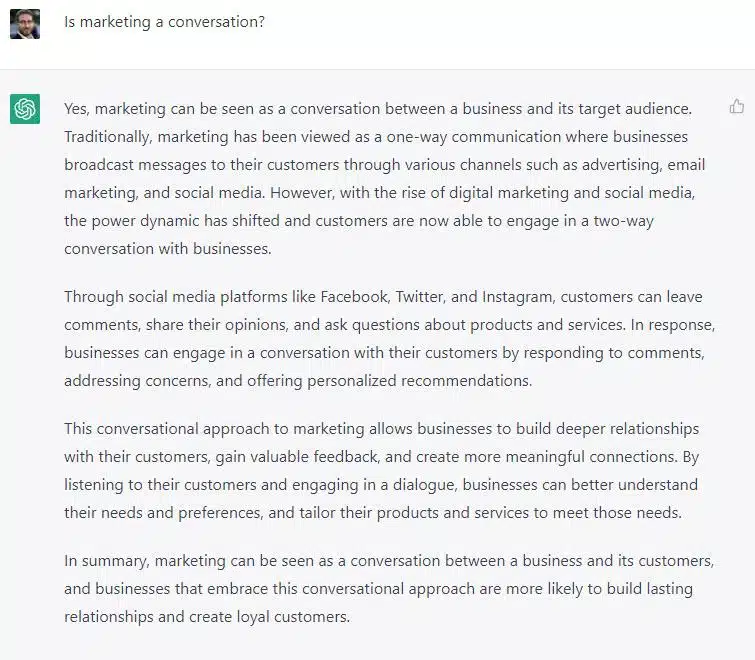Think of a great conversation you’ve had recently. I bet there was give-and-take, great insights and maybe even some entertaining moments. The key to any conversation is at least two people engaging in a substantive back and forth. Marketing is the same.
At the core of all good marketing is a great conversation. Yet, too much of the marketing we see today talks at people. That’s not a conversation.
Marketing is not advertising. Advertising can be a part of a marketing strategy, but it is just that, a part. And too many ads talk at people. Marketing today is about engagement. It’s about generating great content and offering solutions that start a conversation and keep it going.
The most important element of the marketing equation is not the tool or the channel. It is the audience and how that audience engages with the messaging. The tools are just what you use to facilitate that engagement. Let’s go over the fundamentals in this article.
Who are you talking to?
Too many marketers fail to accurately answer this question before engaging in any marketing endeavor.
Starting your marketing campaign without sufficiently defining the target audience is a recipe for wasted time and money. It happens less today than in the past, thanks to the readily available data we can pull from platforms like Google Analytics.
Marketing data paints a picture
Most marketing efforts generate a lot of actionable data. But even before an organization engages in those efforts, relevant and useful data can still be found if they know where to look.
Platforms like Semrush and Ahrefs, for example, will show you the following:
- What keywords are users entering to find your website and the sites of your competitors?
- How are they accessing information from those sites in terms of device and platform used?
- Where are they in the world?
- What are the demographics?
Google Analytics also offers a wealth of data that can tell you a lot about how your audience interacts with content, from acquisition channels to time on page and bounce rate. All these metrics are useful when getting familiar with your audience’s needs and behavioral patterns, but is it enough to really know your audience? My answer is no.
Nothing compares to real human data, and it is available if you look for it. One thing that drives Adele Revella, founder of the Buyer Persona Institute, completely nuts is when people develop so-called buyer personas, having never spoken to an actual buyer.
While tools like Semrush, Ahrefs and others can offer a mountain of useful data, as our CEO always says, “don’t trust the tools!” Check your data. More than that, Revella says, “check your customers.”
Buyer personas are who you’re talking to
Whether you side with Revella and believe that buyer personas should be real people or you believe, as others do, that they can be fictional representations of actual customers, you need to build them based on as much truth as possible.
Revella describes this process using what she calls the “5 rings of buying insight,” which are:
- Priority initiative insight: Hearing real buyers describe the “trigger moment” when your buyers knew they needed to spend money on a problem.
- Success factors insight: These are not the benefits you offer but the prioritized benefits they share with you.
- Perceived barriers: This is where the buyers tell you why they did not select certain products or vendors, including yours.
- Decision criteria: These are the reasons they decided to buy or the value they saw in the product or service features.
- Buyer’s journey: This is the process they use to make a buying decision. Where did they gather information? Who helped them? How long did it take?
Revella recommends a series of phone, online video or in-person interviews with a select group of customers to gather these five insights. Interviews are preferred over surveys because they are conversational and give access to the more nuanced elements of their buying behaviors. Make sure you can record these for future reference.
You would essentially use those five insights as your questions in those interviews. All that data is gold for developing your editorial calendar, understanding what your potential clients are looking for and supporting your sales team.
These are also prime topics of your marketing conversation. Let me explain.
The connected consumer
Today’s customers prefer to feel like they know the company they’re buying from. Especially the younger generations. They want to feel a connection to the companies they give money to.
For example, in my interview with Sarah Weise, author of “Instabrain: The New Rules for Marketing to Generation Z,” she talks about how Gen Z expects personalization in marketing. They rely more on influencers, people they know and the creators of the content they like to find the information they need when making a purchase.
This generation is also incredibly loyal once they feel they have a meaningful connection with a brand. I think this is also starting to be true for other generations, but not quite as pronounced. Either way, building that connection is critical to the marketing conversation.
Dig deeper: Why we care about loyalty marketing
Marketing: Become human
“Content is king.” You’ve surely heard this a few thousand times. Still, it is true, probably more so than ever. Of course, anyone can create content. Machines can create content, sometimes not half-bad content.
A vast ocean of content is out there, and more is coming every day. So, how can you create content that allows you to stand out while creating more opportunities to connect with your buyers?
Study your audience, learn their needs and create content that meets those needs. This is your secret weapon and will give you a competitive edge.
No matter which marketing channel you use, your content must resonate with potential customers — otherwise, they won’t notice it. And each piece of your content, whether an ad, a newsletter or a social media post, must provide real value and be genuinely interesting for your audience.
I would argue that you simply cannot create this kind of content with only a fictional persona based on dry numbers from a marketing dashboard. You must speak to humans. Moreover, you must speak to them in a human voice in your marketing efforts.
Good marketing requires truth and authenticity
Don’t confuse this approach with the fake friendliness many brands embrace today. Those fake marketing efforts take on a new level of cringe-worthiness. And today’s consumers are not buying it anymore. They are aware that brands are out there for their money.
Today’s savvy buyers will part with their money if they feel they’ll get something valuable in return. And this is the point of a marketing conversation: convincing your customers that buying from you is a good thing… for them. How do you do this?
Be honest. Be aware of their needs and provide them with the information they need. Do it in a respectful and meaningful way. Be useful. Be real. Create a community around your brand and be a part of this community.
It might sound simple, but doing this well is quite difficult. It may require you to review your priorities and processes completely. And some parts I mentioned above are almost impossible to translate into the language of dashboards and ROI charts. People buy from people.
Once you start to communicate directly with your customers and better understand them, you may find that your messaging will evolve into something better. Of course, the tools can help. One of which, surprisingly, is…
AI and the future of marketing
Many marketers are discussing the impact of generative AI on content marketing, SEO and more. It’s already happening. AI is being used for marketing by two-thirds of B2B organizations, according to Forrester.
Everyone is talking about ChatGPT. If you’ve used it, you know that it is very much a chat feature. You ask it a question or give it a command, and it answers you.
This is already impacting how search works, and that impact will continue to grow in the near future. Googling something is already a matter of “ask and answer.” You are having a conversation with a machine.
With AI and other marketing technology, this will get easier and easier. To prepare for that, you need to know what questions your buyers will ask. For example:
- Your buyers will use AI-powered chat features on your website and others to get the information they need to lead them to a purchase. You can gain a mountain of useful data from your buyers’ questions.
- AI will power advertising efforts to serve the buyers’ needs better. But be careful with this and ensure you don’t rely blindly on automated ad features.
- AI will generate content based on your buyers’ exact questions.
Of course, AI is a tool. Remember, “don’t trust the tools!” Use your brain, insert your culture and personality. Double-check your information and cite trusted sources. And focus on being a go-to resource for your buyers.
If you treat marketing as an active conversation with give and take and focus on your buyer’s needs, you will see success and develop a devoted fan and customer base who need you just as much as you need them.
Don’t just take my word for it. Listen to our friend, ChatGPT…

Now, get those conversations started!
Get MarTech! Daily. Free. In your inbox.
Opinions expressed in this article are those of the guest author and not necessarily MarTech. Staff authors are listed here.
























































![Social Media Spring Cleaning [Infographic] Social Media Spring Cleaning [Infographic]](https://imgproxy.divecdn.com/9e7sW3TubFHM00yvXe5zvvbhAVriJiGqS8xmVFLPC6s/g:ce/rs:fit:770:435/Z3M6Ly9kaXZlc2l0ZS1zdG9yYWdlL2RpdmVpbWFnZS9zb2NpYWxfc3ByaW5nX2NsZWFuaW5nMi5wbmc=.webp)
![5 Ways to Improve Your LinkedIn Marketing Efforts in 2025 [Infographic] 5 Ways to Improve Your LinkedIn Marketing Efforts in 2025 [Infographic]](https://imgproxy.divecdn.com/Hv-m77iIkXSAtB3IEwA3XAuouMwkZApIeDGDnLy5Yhs/g:ce/rs:fit:770:435/Z3M6Ly9kaXZlc2l0ZS1zdG9yYWdlL2RpdmVpbWFnZS9saW5rZWRpbl9zdHJhdGVneV9pbmZvMi5wbmc=.webp)














